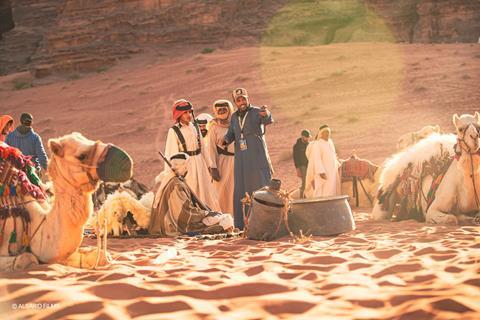
One of only two Saudi titles in Competition at this year’s Red Sea International Film Festival (RSIFF), Mohammed “Moe” Alatawi’s feature debut Within Sand combines aspects of a road movie with the futuristic landscapes found in the northwest of Saudi Arabia, where it was shot.
It is ultimately a tale of survival for its lead character, a young man named Snam, played by newcomer Ra’ed Alshammari, who is ambushed by thieves in the deserted terrain and left with only a knife to fend for himself.
Within Sand feels like a blockbuster simply because the location where it was filmed, Neom, is breathtaking. Desert dunes mix with tall, sandy rock formations, with the Red Sea never too far away.
It won the jury prize at the second RSIFF on Thursday (December 8).
So how does a young filmmaker, in a country whose cinema industry is in its infancy, overcome the obvious challenges and go on to make a film of such magnitude?
“I think filmmaking is challenging in general, regardless of the place where you shoot,” says Alatawi. “Because it’s all about the influence, and I’m influenced by certain films that are big in scale, larger than life and showcase a person’s story in a cinematic form — that is what attracted me to cinema.”
Alatawi credits his producers with having worked out all the logistics and allowing him to “be able to create that sense of a larger than life environment.”
The Saudi-born filmmaker received support from both the Saudi Film Commission, through its Daw Film Competition, and Neom, whom he calls “vital for this production.” In fact, aside from the location support the production received from Neom, which included a hotel-like facility built especially for the cast and crew near the set, Alatawi points out they supported Within Sand both “logistically and financially.” Neom is a $500bn megacity in the making, complete with filming infrastructure, and is the vision of Saudi Crown Prince Mohammed bin Salman.
Alatawi explains how he came to choose Neom: “We went there, we saw the locations and I was so impressed by them,” he says. He then pitched the idea to Neom CEO Nadhmi A. Al-Nasr, who asked the filmmaker if this was a Saudi film, helmed by a Saudi filmmaker. As the answer to both questions was “yes” and Alatawi was met with the reply every filmmaker wishes to hear: “Make the film, go ahead with it.”
Cinematic influences
Born in 1993, Alatawi grew up in a Saudi Arabia without cinemas, but still managed to be influenced by some great filmmakers. “Stanley Kubrick’s films are a great inspiration, and Christopher Nolan’s work is also a huge influence.” He also enjoys David Fincher’s films, and says “the last film I really liked was Uncut Gems with Adam Sandler.”
The path to becoming a filmmaker himself, wasn’t “linear” he says, but it was “a very organic process”. He recalls: “I wanted to study engineering and then law, but when I was very young, around nine or 10, my mom would give me the camcorder and ask me to make films.” It is easy to draw a comparison with the cinematic version of Steven Spielberg’s own mother, Mitzi Fabelman in the US filmmaker’s personal new work, The Fabelmans.
Within Sand has high production values: there are stunning costumes, breathtaking locations but also many camels, a white horse and a wolf — central to the story of Snam’s journey. While most of his crew, and all his actors hail from Saudi, the wolf wrangler on the set was from Hungary and the two wolves used in the shoot are Mongolian. “We didn’t find proper wrangling facilities here in Saudi with Arabian wolves,” Alatawi admits, “so we contacted them and they had two Mongolian wolves, which have the most similarities with the Arabian wolves, they share similar colour and some features.”
As for finding his actors, once again working in a young industry meant that Alatawi had to work with non-professionals. A workshop he took in London with Palestinian Oscar-nominated filmmaker Scandar Copti helped. The techniques taught by Copti, who used non actors in Ajami, the 2009 film he co-directed, were “very beneficial” for the Saudi helmer. Alatawi worked with Ra’ed Alshammari, who plays Snam, and Obaid Alwadaani, who plays his friend Awad “on a daily basis for four months straight, with an acting coach,” before the shoot. Both young actors had the talent says Alatawi, who wanted to use “many other first-time actors in the film,” for both authenticity but also because “that was the point for me, to introduce new cinematic faces to the film industry.”
Alatawi acknowledges that he “probably wouldn’t do another film in the desert anytime soon, but if I were to do one, I would have a different approach because now I have an understanding of the challenges that may arise.”























No comments yet